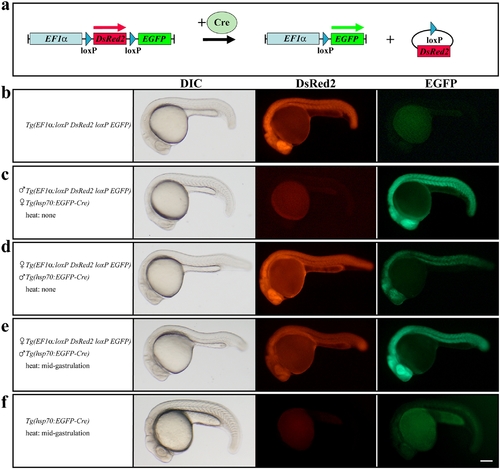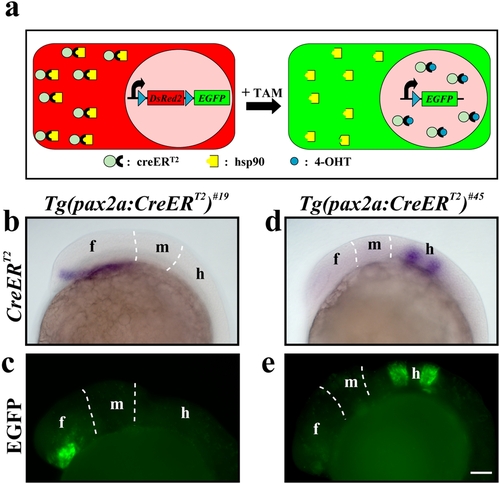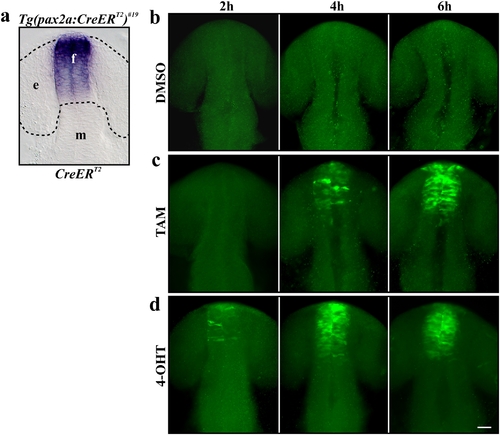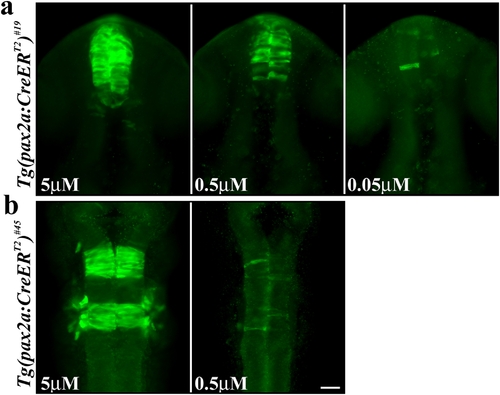- Title
-
Temporally-controlled site-specific recombination in zebrafish
- Authors
- Hans, S., Kaslin, J., Freudenreich, D., and Brand, M.
- Source
- Full text @ PLoS One
|
Cre-mediated recombination in the red-to-green reporter line. (a) Scheme of the recombination event. In the absence of Cre the EF1α promoter drives the expression of DsRed2 but changes to EGFP after successful Cre-mediated recombination. (b) Embryos of the red-to-green reporter line show strong DsRed2 and no EGFP fluorescence. (c) Maternal contribution of the Tg(hsp70:EGFP-Cre) allele results in complete loss of DsRed2 and ubiquitous EGFP expression in double transgenic embryos. (d) Paternal contribution of the Tg(hsp70:EGFP-Cre) allele leads to strong DsRed2 and mosaic EGFP expression in double transgenic embryos. (e) Paternal contribution of the Tg(hsp70:EGFP-Cre) allele and brief heat induction at mid-gastrulation stages results in reduced DsRed2 and strong ubiquitous EGFP expression in double transgenic embryos. (f) Embryos of the Tg(hsp70:EGFP-Cre) line show only weak EGFP fluorescence after brief heat induction at mid-gastrulation stages. b?f Lateral views of live 24 hpf embryos bearing different transgenes. Scale bar, 125 μm. |
|
Ligand-dependent Cre-mediated recombination. (a) Scheme of the ligand-dependent recombination event in cells of the red-to-green reporter line. The chimeric CreERT2 recombinase is retained in the cytoplasm in the absence of the ligand. After administration of TAM which is converted to the active ligand 4-OHT, CreERT2 translocates to the nucleus, where it catalyzes the recombination event. (b) Expression of CreERT2 in the diencephalon of the Tg(pax2a:CreERT2)#19 line at early segmentation stages revealed by in situ hybridization. (c) EGFP expression in the diencephalon of double transgenic embryos at 24 hpf bearing the red-to-green reporter and the Tg(pax2a:CreERT2)#19 alleles after TAM treatment at mid-gastrulation stages. (d) Expression of CreERT2 in rhombomere 3 and 5 of the Tg(pax2a:CreERT2)#45 line at early segmentation stages revealed by in situ hybridization. (e) EGFP expression in rhombomere 3 and 5 of double transgenic embryos at 24 hpf bearing the red-to-green reporter and the Tg(pax2a:CreERT2)#45 alleles after TAM treatment at mid-gastrulation stages. Abbreviations: f, forebrain; h, hindbrain; m, midbrain. Scale bar, 50 μm. |
|
Kinetics of ligand-dependent Cre-mediated recombination. (a) Expression of CreERT2 in the Tg(pax2a:CreERT2)#19 line at the 12-somite stage revealed by in situ hybridization. (b) Control embryos treated with DMSO never show any EGFP. (c) Immunofluorescence staining with antibodies to EGFP is detectable 4 hours after application of TAM and expanded further after 6 hours. (d) Onset of EGFP expression by immunofluorescence staining is detected after 2 hours and expanded further after 4 and 6 hours after application of 4-OHT. a?d Dorsal views of double transgenic embryos at 12-, 16-, 20 and 24-somite stage (15, 17, 19 and 21 hpf). Abbreviations: f, forebrain; e, eye anlage; h, hours; m, midbrain. Scale bar, 30 μm. |
|
Dose-dependent recombination in the Tg(pax2a:CreERT2)#19 and Tg(pax2a:CreERT2)#45 lines by TAM. (a) Double transgenic embryos bearing the red-to-green reporter and the Tg(pax2a:CreERT2)#19 alleles show strong EGFP expression in the diencephalon after application of 5 μM TAM at mid-gastrulation stages. Application of 0.5 μM TAM or 0.05 μM TAM at the same stage, results in reduced EGFP expression or single EGFP-positive cells, respectively. (b) Double transgenic embryos bearing the red-to-green reporter and the Tg(pax2a:CreERT2)#45 alleles show strong EGFP expression in rhombomere 3 and 5 after application of 5 μM TAM at mid-gastrulation stages. Application of 0.5 μM TAM at the same stage, results in single EGFP-positive cells. a, b Dorsal views of double transgenic embryos at 24 hpf. Scale bar, 30 μm. |




